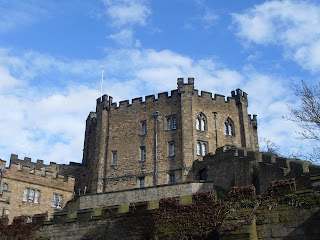He [Lewis de Beaumont, Bishop of Durham, 1316-33] was chaste but illiterate. He did not understand Latin and had trouble pronouncing it. Thus, during his episcopal consecration when he was obliged to make his profession, he was unable to read it aloud even though he had previously been coached for many days.
- Historiae Dunelmensis Scriptores Tres, Robert Graystanes
I seigh a tour on a toft trieliche ymaked,
A deep dale bynethe,
- The Vision of Piers Plowman, William Langland
So long they traueiled with litle ease,
Till at last they to a Castle came,
Built on a rocke adioyning to the seas:
It was an auncient worke of antique fame,
And wondrous strong by nature, and by skilfull frame.
- The Faerie Queene, Edmund Spenser
Whenas they spide a goodly castle, plast
Foreby a riuer in a pleasant dale
Foreby a riuer in a pleasant dale
- The Faerie Queene, Edmund Spenser
As can be read from the description of Lewis de Beaumont, Medieval bishops could be rather wordly specimens, and Durham was more than most dioceses prone to produce or attract such bishops due to its proximity to the Scottish border and thence the necessity of the people of Durham to occasionally engage in warfare. Lewis, however, appears to have been more mundanely orientated than most, since the chronicler describes him as greedy and greatly preoccupied with his household and "his lavish excesses". He did not, as the quote informs us, master Latin and when struggling with the phrase "in aenigmate" from Corinthians 13:12 during his episcopal consecration, he invoked St. Louis, a French royal saint, and complained to those near him. How Lewis managed to become concecrated as bishop of Durham is beyond my knowledge, but perhaps it was precisely due to his mundane qualities, or maybe due to his blood-relationship with the kings of France and Sicily.
In later ages the bishops of Durham have been referred to as Prince-Bishops. The phrase is understandable both from characters such as Lewis de Beaumont and from Durham Castle, situated adjacent to the cathedral on the site of an older fortress. Durham Castle used to be the residence of the Bishop since William the Conqueror ordered it built in 1072 following a campaign in Scotland, probably both to serve as a stronghold against Scottish invasions and in the case of civil revolt. Later bishops have added to the structure and the current complex has elements from most - if not all - epochs succeeding the Norman invasion.
This is a prime example of 19th century medievalism.
A Norman chapel is still extant in the lower parts of the castle. It is a small room, faintly lit by a couple of weak lightbulbs in order to preserve the stone, and its pillars have some magnificent carvings in Anglo-Saxon style. Personally I was most attracted to a hunting scene depicting hunters chasing a stag on the capital in an eternal, never-ending pursuit. The chapel is still in use and occasionally plays have been performed there, among them - if I remember correctly - Samuel Beckett's Endgame.
Following the castle's conversion into a university complex in the 1800s numerous alterations were made. The above building, the keep, is now housing accommodation for about 60 students.
The keep functioned as a watchtower and the ultimate line of defence. The first keep was made of wood.

Approximately underneath the clocktower lies the Norman chapel, which was rediscovered in the 1900s, if I remember correctly.

The castle is only open to students and tourists on guided tours, since this is a functioning university college. Consequently we were not allowed to take pictures, nor allowed to roam about ourselves. However, the tour includes (unless my memory fails me) a 15th century kitchen and a 17th century chapel, both still in use, and it is well worth the time and money.
















Ingen kommentarer:
Legg inn en kommentar